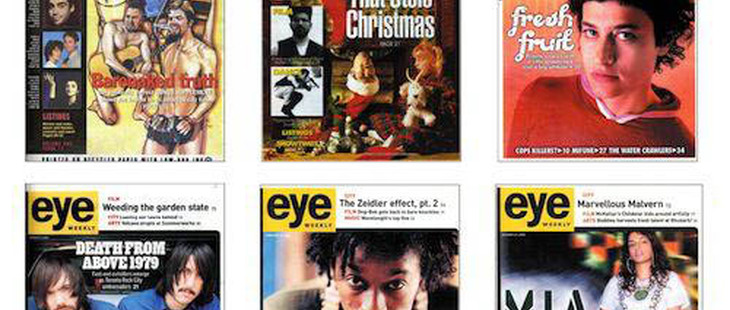
“I found some really good columnists,” William Burrill says, talking about his memories of being the founding editor at what was then known as eYe Weekly. “Donna Lypchuk, who became one of our star columnists – I hired her because when I interviewed her, she showed me a Polaroid of her breakfast. That may seem weird.”
It does. And it did. Though it was owned by the Star and set up by Burrill, who was an editor there, Eye started out taking its alternativeness very seriously.
By the time it died last week, aged 19 years and seven months, it had gone through half a dozen phases, all represented by the 40 or so people who gathered at the Wheat Sheaf pub at the corner of King and Bathurst to toast its passing.
The Sheaf was undergoing a renovation of its own, and is within a couple of blocks of Eye’s first three offices, on Draper, Spadina and Adelaide respectively. The pub was dark and a little grimy, as usual, and it was Friday the 13th, all of which made it the perfect occasion to celebrate, mourn, or merely slough off this unlucky, sometimes ratty, sometimes aspirational paper that was often better than NOW, but never more successful.
From its most recent past, there were former editors Kieran Grant and Caroline Lock, both let go in the prelude to the recycling of the magazine into The Grid. They were hired during Eye’s so-called “Torontopian” phase, which ran roughly 2002-2006 and was either the paper’s third or fourth era depending on how you count them. They were the last from those days to be let go (only Stuart Berman and Ed Keenan remain) in the sort of purge that’s become common among magazines in transition. Oddly, neither Grant nor Lock, nor most of the other gathered alumni, many of whom had been greatly wronged in one way or another by one publisher or another, had much bad to say about Eye or The Grid. Eye was great, at times, a hoot at others, but had gotten sick and had begun to drift, and no one blamed the poor thing.
Catharine Tunnacliffe was also there, the managing editor that hired Grant and Lock and presided over the era. Back then, Eye was one of the first to tap into the city’s early-decade enthusiasm about itself, replacing its news section with a city section written, among many others, by future Stroll author Shawn Micallef, Ann Ireland, and Ed Keenan along with former mayor John Sewell, cartoonist and Spacing co-founder Matt Blackett, and future city councilor Gord Perks — the lot of them mapped the city culturally, politically and psychogeographically in a way that hadn’t been done before. It was the first paper to endorse Miller for mayor, putting him on the cover dressed as a superhero; this at a time when he seemed an unlikely choice in a field that included front-runner Barbara Hall and a still golden John Tory.
Nate Hendley was there, too, a staff writer from the era immediately preceding that one, when under Bill Reynolds and news editor Greg Boyd, the paper got serious about news and ran long investigative pieces by Hendley and fellow staff writer Bruce Livesey. Pieces like Hendley’s “Is the Party Over,” which ran in the Aug. 26 issue in 1999 — an early look at ecstasy-related deaths. It’s just one of the stories I’d love to link to, but can’t, since Eye broke all its links several years ago during an ill-advised web re-design.
Put together by many of the same people who were there from the beginning, this phase marked a maturing for both the paper and its staff, who’d had their fun and now were getting serious about their craft. Reynolds would go on to be a professor of journalism at Ryerson, and Greg Boyd is now a senior editor at the Globe. They had an office at City Hall. It might very well have continued to mature along with its staff if a fight hadn’t erupted between Reynolds and his publisher about the advertorial treatment of a car show. That ended with Reynolds being canned and all of his staff (save Tunnacliffe, then the brand new film editor) resigning in protest.
The question of whether Eye had a golden age came up several times at the Wheat Sheaf wake. Unfortunately, no one got outrageously drunk and attempted to defend their days as the greatest days, but as far as I can tell, people seem to think there were a few: such as those Tunnacliffe/Torontopia years, roughly 2003-2006, and the Reynolds renaissance, about 1997-2001.
But according to two people who’d been with Eye for its entire history, sales rep Peter Lennon and film critic Jason Anderson, both of whom started working for the paper in 1991, nothing could match those first couple of years. By the end of the evening, as much of the crowd had drifted out of the Sheaf and into whatever they were doing next, Anderson and Lennon found each other at the bar. They were talking about the Burrill years. Canada’s answer to gonzo journalism, Burrill hired a bunch of young freelance columnists like Lypchuk and Chris O’Connor who spoke to their audience – primarily boys and men between 15 and 25, it would seem – more directly and compellingly than anyone else was doing at the point. It was radically different. And though it was a difference many people disliked – it was often called fratboy journalism – the paper cohered in tone in a way few publications ever do.
I asked Burrill by phone a little before the wake – neither he nor Reynolds (nor Lypchuk) showed – what stories stood out most in his mind from his years at Eye. We talked for 45 minutes, about the time he ran for mayor, the time the staff sent out press kits for a fake band to see if record companies would bite (or even listen to the demo tapes), and the time they dressed up new humour columnist Andrew Clark in a beret, gave him a bouquet of celery, and tried to convince people he was a performance artist named Chez Noir.
It was only at the end of the conversation, when I hadn’t heard a single headline, or a quoted paragraph or any reference to text at all, that I realized Burrill’s favourite stories were all records of some outrageous or provocative act. It’s an entirely different approach to journalism, one that doesn’t have much precedent or any obvious successor in Canadian media. While everyone else was commenting on the cultural ubiquity of Madonna in the early ’90s, Burrill’s Eye put out an all-Madonna issue, working the singer’s name into every single one of its stories. Its content was its comment.
Burrill figures Eye jumped the shark in 1998, the year his last Naked Eye column ran. After that everyone waited for Eye to sell-out or go straight, which was to be expected from the corporate-owned competitor to the independent NOW, but it never really did. Well, not until the past year perhaps, when in the run-up to The Grid the paper shrugged off almost two decades of being a reflection of the people who worked there and started trying instead to be a reflection of the people its advertisers wanted to read it, with increasing attention paid to fashion, beauty products, babies, cars and real estate.
The Grid promises to be more the logical extension of this latter period than any of Eye’s previous and possibly financially foolish kicks at the can, so maybe it’s not such a bad thing that it’s ceased to exist entirely just five months short of its 20th birthday. Like a friend who dies in high school, never having to get a boring job and support a family, it remains a teenager forever.
Bert Archer worked at Eye from 2002-2005 as production editor and city editor.















